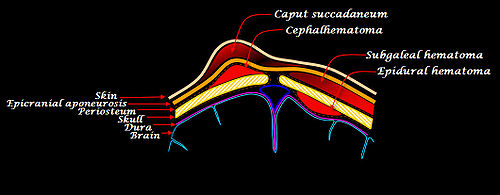- Cephalhematoma
-
Cephalohematoma Classification and external resources ICD-10 P12 ICD-9 767.19 A cephalohematoma (American English) or cephalohaematoma (British English) is a hemorrhage of blood between the skull and the periosteum of a newborn baby secondary to rupture of blood vessels crossing the periosteum. Because the swelling is subperiosteal its boundaries are limited by the individual bones, in contrast to a chignon.
Contents
Causes
The usual causes of a cephalohematoma are a prolonged second stage of labor or instrumental delivery, particularly ventouse.
Symptoms
If severe the child may develop jaundice, anemia or hypotension. In some cases it may be an indication of a linear skull fracture or be at risk of an infection leading to osteomyelitis or meningitis.
The swelling of a cephalohematoma takes weeks to resolve as the blood clot is slowly absorbed from the periphery towards the centre. In time the swelling hardens (calcification) leaving a relatively softer centre so that it appears as a 'depressed fracture'.
Cephalohematoma should be distinguished from another scalp bleeding called subgaleal hemorrhage (also called subaponeurotic hemorrhage), which is blood between the scalp and skull bone (above the periosteum) and is more extensive. It is more prone to complications, especially anemia and bruising.
Management
No laboratory studies usually are necessary. Vitamin C has been reported to hurry the resorption of hematoma. Skull x-ray or CT scanning is used if neurological symptoms appear. Usual management is mainly observation. Transfusion and phototherapy may be necessary if blood accumulation is significant. Aspiration is more likely to increase the risk of infection. The presence of a bleeding disorder should be considered. Skull radiography or CT scanning is also used if concomitant depressed skull fracture is a possibility.
See also
Certain conditions originating in the perinatal period / fetal disease (P, 760–779) Maternal factors and
complications of pregnancy,
labour and deliveryLength of gestation
and fetal growthSmall for gestational age/Large for gestational age · Preterm birth/Postmature birth · Intrauterine growth restrictionBirth trauma scalp (Cephalhematoma, Chignon, Caput succedaneum, Subgaleal hemorrhage) · Brachial plexus lesion (Erb's palsy, Klumpke paralysis)By system HDN (ABO • Anti-Kell • Rh c • Rh D • Rh E) · Hydrops fetalis · Hyperbilirubinemia (Kernicterus, Neonatal jaundice)Erythema toxicum · Sclerema neonatorumInfectious Other External links
Categories:
Wikimedia Foundation. 2010.

